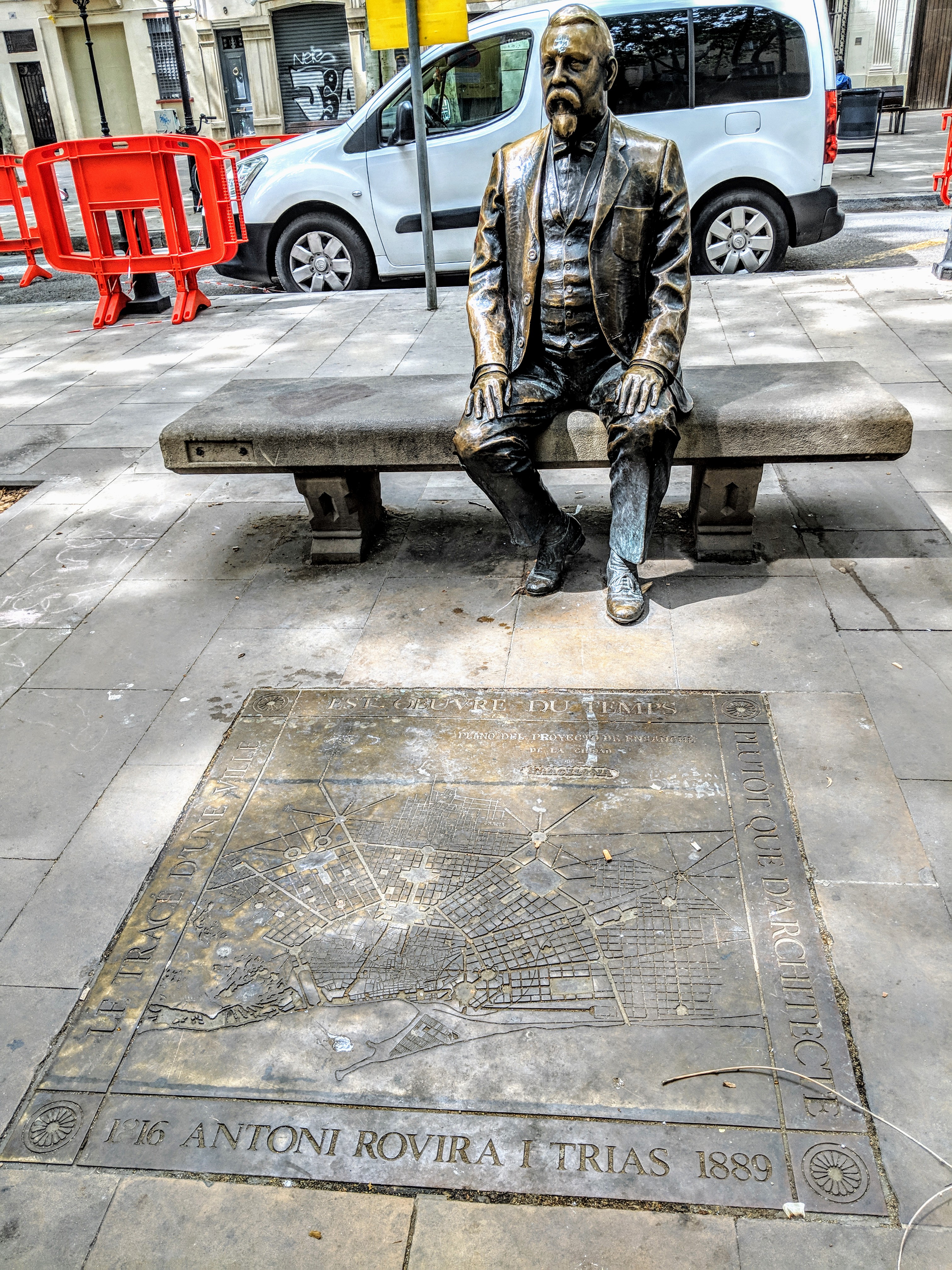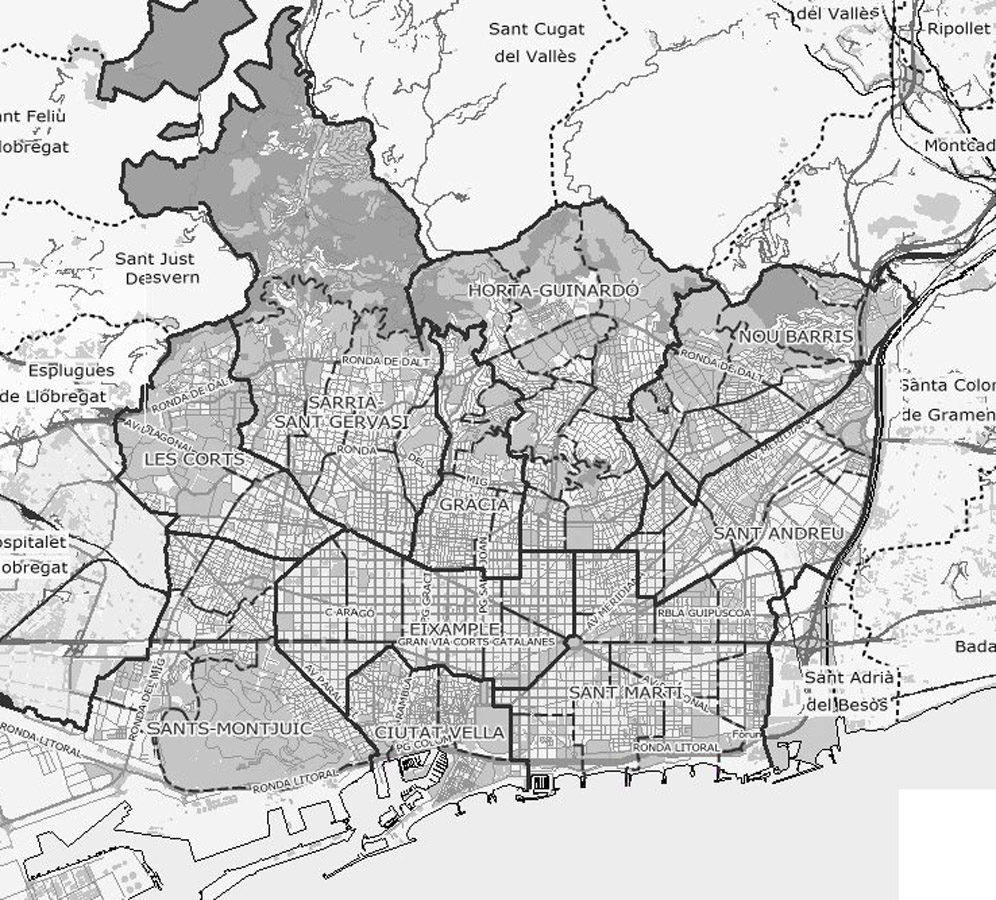|
Antoni Rovira I Trias
Antoni Rovira i Trias (1816 in Barcelona – 1889 in Barcelona) was a Catalan architect, urban planner and founder of several associations, among them Societat Filomàtica de Barcelona. He is known as the architect of several buildings in Barcelona, among them the markets of Barceloneta (1873), La Concepció (1885; on career d'Aragó), El Born (1876) and Sant Antoni (1879). He is also responsible for the Passatge del Comerç (1855), Teatre Circ Barcelonès (1853) and the construction of the loggia of Palau Moja (1856) and, vital to the development of the city, the demolition of the Ciutadella, the 18th-century military citadel. His radial urban plan for Barcelona, under the name ''Le tracé d’une ville est oeuvre du temps plutôt que d’architecte'' rivalled with Ildefons Cerdà's, and won the 1859 municipal contest by city council's decree, but the central Spanish government in Madrid favoured Cerdà's over his, and construction started the following year. Eventually, ... [...More Info...] [...Related Items...] OR: [Wikipedia] [Google] [Baidu] |
Radial
Radial is a geometric term of location which may refer to: Mathematics and Direction * Vector (geometric) In mathematics, physics, and engineering, a Euclidean vector or simply a vector (sometimes called a geometric vector or spatial vector) is a geometric object that has magnitude (or length) and direction. Vectors can be added to other vectors ac ..., a line * Radius, adjective form of * Radial distance, a directional coordinate in a polar coordinate system * Radial set * A bearing from a waypoint, such as a VHF omnidirectional range Biology * Radial artery, the main artery of the lateral aspect of the forearm * Radial nerve, supplies the posterior portion of the upper limb * Radial symmetry, one of the types of distribution of body parts or shapes in biology * Radius (bone), a bone of the forearm Technology * Radial (radio), lines which radiate from a radio antenna * Radial axle, on a locomotive or carriage * Radial compressor * Radial delayed blowback * Radial engine * ... [...More Info...] [...Related Items...] OR: [Wikipedia] [Google] [Baidu] |
1816 Births
This year was known as the ''Year Without a Summer'', because of low temperatures in the Northern Hemisphere, possibly the result of the Mount Tambora volcanic eruption in Indonesia in 1815, causing severe global cooling, catastrophic in some locations. Events January–March * December 25 1815–January 6 – Tsar Alexander I of Russia signs an order, expelling the Jesuits from St. Petersburg and Moscow. * January 9 – Sir Humphry Davy's Davy lamp is first tested underground as a coal mining safety lamp, at Hebburn Colliery in northeast England. * January 17 – Fire nearly destroys the city of St. John's, Newfoundland. * February 10 – Friedrich Karl Ludwig, Duke of Schleswig-Holstein-Sonderburg-Beck, dies and is succeeded by Friedrich Wilhelm, his son and founder of the House of Glücksburg. * February 20 – Gioachino Rossini's opera buffa ''The Barber of Seville'' premières at the Teatro Argentina in Rome. * March 1 – The Gork ... [...More Info...] [...Related Items...] OR: [Wikipedia] [Google] [Baidu] |
Spanish Urban Planners
Spanish might refer to: * Items from or related to Spain: **Spaniards are a nation and ethnic group indigenous to Spain **Spanish language, spoken in Spain and many Latin American countries **Spanish cuisine Other places * Spanish, Ontario, Canada * Spanish River (other), the name of several rivers * Spanish Town, Jamaica Other uses * John J. Spanish (1922–2019), American politician * "Spanish" (song), a single by Craig David, 2003 See also * * * Español (other) * Spain (other) * España (other) * Espanola (other) * Hispania, the Roman and Greek name for the Iberian Peninsula * Hispanic, the people, nations, and cultures that have a historical link to Spain * Hispanic (other) * Hispanism * Spain (other) * National and regional identity in Spain * Culture of Spain * Spanish Fort (other) Spanish Fort or Old Spanish Fort may refer to: United States * Spanish Fort, Alabama, a city * Spanish Fo ... [...More Info...] [...Related Items...] OR: [Wikipedia] [Google] [Baidu] |
Architects From Catalonia
An architect is a person who plans, designs and oversees the construction of buildings. To practice architecture means to provide services in connection with the design of buildings and the space within the site surrounding the buildings that have human occupancy or use as their principal purpose. Etymologically, the term architect derives from the Latin ''architectus'', which derives from the Greek (''arkhi-'', chief + ''tekton'', builder), i.e., chief builder. The professional requirements for architects vary from place to place. An architect's decisions affect public safety, and thus the architect must undergo specialized training consisting of advanced education and a ''practicum'' (or internship) for practical experience to earn a license to practice architecture. Practical, technical, and academic requirements for becoming an architect vary by jurisdiction, though the formal study of architecture in academic institutions has played a pivotal role in the development of the ... [...More Info...] [...Related Items...] OR: [Wikipedia] [Google] [Baidu] |
People From Barcelona
A person ( : people) is a being that has certain capacities or attributes such as reason, morality, consciousness or self-consciousness, and being a part of a culturally established form of social relations such as kinship, ownership of property, or legal responsibility. The defining features of personhood and, consequently, what makes a person count as a person, differ widely among cultures and contexts. In addition to the question of personhood, of what makes a being count as a person to begin with, there are further questions about personal identity and self: both about what makes any particular person that particular person instead of another, and about what makes a person at one time the same person as they were or will be at another time despite any intervening changes. The plural form "people" is often used to refer to an entire nation or ethnic group (as in "a people"), and this was the original meaning of the word; it subsequently acquired its use as a plural form of ... [...More Info...] [...Related Items...] OR: [Wikipedia] [Google] [Baidu] |
Urban Planning Of Barcelona
The urban planning of Barcelona developed in accordance with the historical and territorial changes of the city, and in line with other defining factors of public space, such as architecture, urban infrastructure and the adaptation and maintenance of natural spaces, parks and gardens. The urban evolution of Barcelona has been constant since its foundation in Roman times to the present day, although since the nineteenth century it has been accentuated thanks to the ''Eixample'' plan and the aggregation of neighboring municipalities. Until the nineteenth century the city was constrained by its medieval walls as it was considered a military square, so its growth was limited. The situation changed with the demolition of the walls and the donation to the city of the fortress of the Citadel, which led to the expansion of the city across the adjacent plain, a fact that was reflected in the Eixample project drawn up by Ildefons Cerdà, which was the largest territorial expansion of Barcel ... [...More Info...] [...Related Items...] OR: [Wikipedia] [Google] [Baidu] |



_1938.jpg)
